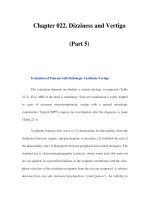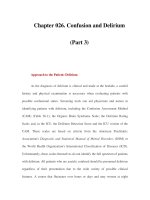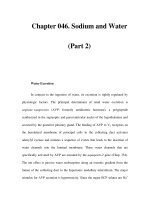Chapter 046. Sodium and Water (Part 10) pptx
Bạn đang xem bản rút gọn của tài liệu. Xem và tải ngay bản đầy đủ của tài liệu tại đây (116.71 KB, 5 trang )
Chapter 046. Sodium and Water
(Part 10)
Figure 46-2
Many causes of hypernatremia are associated with polyuria and a
submaximal urine osmolality. The product of the urine volume and osmolality,
i.e., the solute excretion rate, is helpful in determining the basis of the polyuria
(see above). To maintain a steady state, total solute excretion must equal solute
production. As stated above, individuals eating a normal diet generate ~600
mosmol/d. Therefore, daily solute excretion in excess of 750 mosmol defines an
osmotic diuresis. This can be confirmed by measuring the urine glucose and urea.
In general, both CDI and NDI present with polyuria and hypotonic urine (urine
osmolality <250 mosmol/kg). The degree of hypernatremia is usually mild unless
there is an associated thirst abnormality. The clinical history, physical
examination, and pertinent laboratory data can often rule out causes of acquired
NDI. CDI and NDI can generally be distinguished by administering the AVP
analogue desmopressin (10 µg intranasally) after careful water restriction. The
urine osmolality should increase by at least 50% in CDI and will not change in
NDI. Unfortunately, the diagnosis may sometimes be difficult due to partial
defects in AVP secretion and action.[newpage]
Hypernatremia: Treatment
The therapeutic goals are to stop ongoing water loss by treating the
underlying cause and to correct the water deficit. The ECF volume should be
restored in hypovolemic patients. The quantity of water required to correct the
deficit can be calculated from the following equation:
In hypernatremia due to water loss, total body water is approximately 50
and 40% of lean body weight in men and women, respectively. For example, a 50-
kg woman with a plasma Na
+
concentration of 160 mmol/L has an estimated free-
water deficit of 2.9 L {[(160 – 140) ÷ 140] x (0.4 x 50)}. As in hyponatremia,
rapid correction of hypernatremia is potentially dangerous. In this case, a sudden
decrease in osmolality could potentially cause a rapid shift of water into cells that
have undergone osmotic adaptation. This would result in swollen brain cells and
increase the risk of seizures or permanent neurologic damage. Therefore, the water
deficit should be corrected slowly over at least 48–72 h. When calculating the rate
of water replacement, ongoing losses should be taken into account, and the plasma
Na
+
concentration should be lowered by 0.5 mmol/L per h and by no more than 12
mmol/L over the first 24 h.
The safest route of administration of water is by mouth or via a nasogastric
tube (or other feeding tube). Alternatively, 5% dextrose in water or half-isotonic
saline can be given intravenously. The appropriate treatment of CDI consists of
administering desmopressin intranasally (Chap. 334). Other options for decreasing
urine output include a low-salt diet in combination with low-dose thiazide diuretic
therapy.
In some patients with partial CDI, drugs that either stimulate AVP secretion
or enhance its action on the kidney have been useful. These include
chlorpropamide, clofibrate, carbamazepine, and nonsteroidal anti-inflammatory
drugs (NSAIDs).
The concentrating defect in NDI may be reversible by treating the
underlying disorder or eliminating the offending drug. Symptomatic polyuria due
to NDI can be treated with a low-Na
+
diet and thiazide diuretics, as described
above.
This induces mild volume depletion, which leads to enhanced proximal
reabsorption of salt and water and decreased delivery to the site of action of AVP,
the collecting duct.
By impairing renal prostaglandin synthesis, NSAIDs potentiate AVP action
and thereby increase urine osmolality and decrease urine volume. Amiloride may
be useful in patients with NDI who need to be on lithium. The nephrotoxicity of
lithium requires the drug to be taken up into collecting duct cells via the amiloride-
sensitive Na
+
channel.









